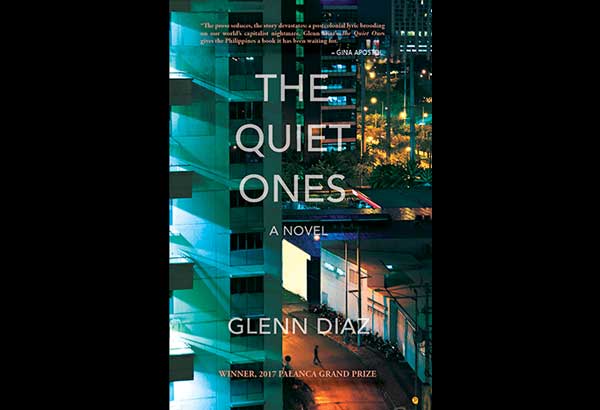Familiar Alienations in Diaz’s ‘The Quiet Ones’

The 2017 Palanca Award Grand Prize winner is set to publish its book this November.
Winning the Grand Prize in this year’s Palanca Awards is not the greatest feat of Glenn Diaz’s first book, The Quiet Ones (Ateneo Press, 2017). As Philippine literature loses an entire generation to Wattpad and the recent slough of Hollywoodized paperbacks, Diaz draws his knives out and comes up with a novel that is at once necessary and pleasurable. The Quiet Ones gives us a clear picture of where we are now and it does so minus the melodrama, gore and obvious symbolism Philippine literature traditionally prepossesses; hilarious in the same way that we laugh over unpaid overtime work. It’s a wonder it won at the Palancas.
The book begins in one of NAIA’s terminals where Alvin, a call center agent who recently quit his post, waits to board his flight to Tacloban (pre-Yolanda) in an attempt to dust the cops away from his trail. We learn he has conspired with his friends at work to successfully embezzle a huge amount of US currency. Not unintelligent, Alvin thinks he had sound motives and a clean escape sorted out. Now in search of a cause, he runs away with his millions and tries to hide.
This storyline holds the book together. But what really makes the book both so funny and heartbreaking are the lives of its many protagonists which are, in many ways, their own but not quite; lives that are connected but not in the sticky, sappy way we imagine them to be. The Quiet Ones does not proffer a solution to this country’s plethora of woes and no, it does not even mention tokhang. Instead, it makes you laugh and cry and wonder why — and more importantly, how — you got the book’s depressing humor. In the end, it leads you to double-take on the way we view ourselves and ask, “Are we, in all honesty, sad?”
That the novel is set in this millennium, well beyond the stuff of mustachioed ilustrados and decades after the dark years under Marcos, is already a step forward. This does not mean to say that it ignores or glosses over the much-lauded “historical (and unabashedly political) roots of our poverty.” Rather, the novel depicts these in ways that are seemingly and entertainingly non-violent, in ways that we, the middle class, have all grown too used to: in friendly conversations, in inspired, pseudo-intellectual arguments, in office meetings and seminars, etc., etc. Diaz tells these stories in sentences that are plain and muscular. His material is heavy while his prose remains unassuming, the author ultimately one with his Quiet Ones.
All too real
As Diaz presents a story that depicts the world and its all-too-real consequences, his style places a high premium on the familiar and the plausible, if not actual events happening as we speak. What’s remarkable in The Quiet Ones, however, is how it locates these meaningful incidences somewhere beyond the grand political timelines and commentaries everyone is too prone to air on social media these days. Instead, the book focuses attention on the tiny, insidious details that govern our daily lives. Take this passage, for example. The unsure Alvin muses aloud about the visual noise telephone cables and livewires make:
“My phone’s bugged again.” She looked up to the dishevel of black cables, which seemed to frame every open space in the city.
Scott had complained about them once, said he couldn’t take a decent picture in Manila without the tangle of wires. “But maybe that’s the point, ‘no? Our attempts at connection coalescing—” I interrupted that train of thought and told him that the lines used to be neat, a sign of progress, until they swelled beyond control, around each other, in every angle imaginable, an instant Rorschach everywhere you turned, until the unsightly webs grew beyond any visible unravelling.
Nation, narratives, etc. etc.
As a piece of Philippine literature set in the present times, The Quiet Ones necessarily argues something about nation and identity, and it does this by setting the spotlight on a usually unpronounced though crucial aspect of our survival — the workplace. There, where our humanities are partitioned into three — making friends, surviving office politics, and most importantly, earning money — the book presents a view that is largely unheard of in Philippine literature in English: that all this talk about a Filipino identity is impotent in the face of money and the machine.
Here is where The Quiet Ones succeeds largely. In portraying what is at once home, colonial and alien, the book takes its readers to task with the question, “Where do we fall in this mess?”
And while Diaz drops clues of a geography so familiar to us, the picture he paints is no Amorsolo, no photograph endorsed by the President’s men, and his voice makes no nostalgic attempt to echo an Anglophonic Balagtas. Instead, he sits us down in a hall awash with white light, subservient to a time zone that isn’t ours, and he tells us a tale that could’ve happened anywhere and nowhere at the same time.
* * *
The Quiet Ones will be part of Ateneo Press’s upcoming book launch early this November.















